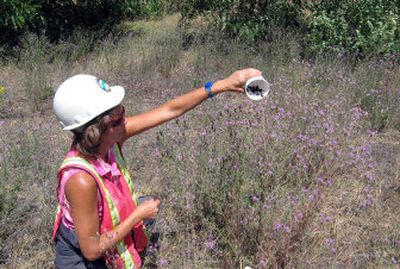Weevils enlisted in knapweed fight

Hundreds of little flower weevils are moving in on spotted knapweed plants in the Bunker Hill Superfund site, where the purple-blossomed noxious weed has infested areas disturbed during Superfund cleanup and begun choking out other vegetation.
The release of 1,400 of the bugs last week is part of a relatively new “biocontrol” that uses the weed’s natural predators, bugs that keep knapweed in check in Europe but didn’t make it to the United States when the weed was introduced in contaminated seeds a century ago.
Jan Olsen, Bunker Hill onsite coordinator for the Idaho Department of Environmental Quality, said the two-bug approach she’s trying on the Superfund site has worked elsewhere.
“It’s been proven – we wouldn’t have done it if it hadn’t been proven,” she said. “One of our contractors has done a lot of work with it in the Moscow area.”
Last week, 1,400 flower-head weevils were released among the spotted knapweed at nine locations within the Superfund site – along a bike trail, near the airport, at a gun range, and at other locations where there’s no regular scheduled weed control.
Within the next month or so, another batch of bugs – this time, root-boring weevils – will be released to follow up on the job. Between the two, the weeds will be attacked at both the flower and the roots, which Olsen hopes will result in a large reduction in knapweed in the area within three to four years.
“It was important to get these flower-head weevils out immediately because they’re flowering now, so we had a two-week window,” she explained. The root-boring weevils are on order. “I’ve got through September to get the root weevils out there,” Olsen said.
The flower weevil lays its eggs in the spotted knapweed’s small, round, lavender flowers. After the eggs hatch, the larva feed on the developing seeds inside the seed head of the flower, reducing the plant’s ability to reproduce, according to the DEQ.
The root-boring weevil lays its eggs on the plant’s root crown, and when its eggs hatch, the larvae bore right into the root, damaging the plant tissue that allows water to move from the root to the rest of the plant.
“It’s good to use both these weevils – they work together,” Olsen said.
One of the reasons knapweed is considered a noxious weed is that it’s so prolific – it reproduces like crazy. The weed infests millions of acres around the nation, and is commonly seen along highways in Idaho where its bachelor button-like purple flowers and spiny branches are easy to spot.
The Idaho Association of Soil Conservation Districts reports on its Web site that each plant can produce 25,000 seeds, and those seeds can remain viable for eight years.
Plus, knapweed specializes in choking out other vegetation by releasing a toxin that reduces growth of other types of plants.
“It has a way of promoting its own growth by killing out competition vegetation under it. So that what you’re going to find is nothing else is going to grow in that area,” Olsen said.
Regular maintenance – including watering, mowing, spraying and fertilizing – can keep spotted knapweed at bay. But that’s not feasible in places like along the bike path, where there is no regular weed maintenance, Olsen said.
She’s a member of Shoshone County’s weed committee, and said the county weed superintendent has used the same approach elsewhere in the county. So far, not enough time has passed to evaluate results.
“The reduction of the spotted knapweed will be visible but not immediate – these bugs need time to do their little magic,” Olsen said. “It’s going to take three or four years.”